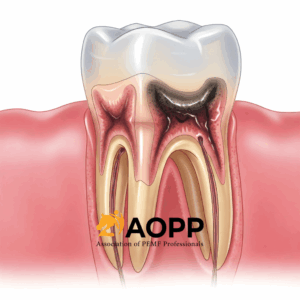 The main problem after orthodontic treatment is relapse, which is a change in tooth position. The etiology of relapse is multifactorial, although the most proposed is the ongoing process of periodontal tissue remodeling and osteogenesis around the moved teeth.1, 2, 3, 4, 5 Previous research on 67 patients who had worn retainers for an average of 8.5 years showed that five patients still experienced relapse after the retainer was removed.6 The results of research on experimental animals with tooth movement for 12 days and retainer use for 2 and 4 weeks showed relapse of 85% and 24%, respectively.2
The main problem after orthodontic treatment is relapse, which is a change in tooth position. The etiology of relapse is multifactorial, although the most proposed is the ongoing process of periodontal tissue remodeling and osteogenesis around the moved teeth.1, 2, 3, 4, 5 Previous research on 67 patients who had worn retainers for an average of 8.5 years showed that five patients still experienced relapse after the retainer was removed.6 The results of research on experimental animals with tooth movement for 12 days and retainer use for 2 and 4 weeks showed relapse of 85% and 24%, respectively.2
Alveolar bone deposition and periodontal ligament remodeling play an important role in preventing relapse after orthodontic treatment. The cells involved in osteogenesis are osteoblasts, osteoclasts, and osteocytes,5 while the cells involved in periodontal ligament remodeling are fibroblasts. Type I collagen (Col-I) and fibroblast growth factor 2 (FGF-2) are the main mediators in the process of periodontal ligament and alveolar bone remodeling. Col-I is responsible for the formation of Col fibers and is also an important mediator of bone formation. FGF-2 plays an important role in the formation of new blood vessels by stimulating fibroblast proliferation and Col production during the process of alveolar bone and periodontal ligament remodeling.7
Several efforts are made to prevent relapse. Pulsed electromagnetic fields (PEMFs) are a non-invasive adjunctive therapy for osteoporosis in postmenopausal women,8 mandibular fractures,9 and improving osseointegration of implants in the alveolar bone.10, 11, 12 Although the biomolecular effects of PEMF on alveolar bone cells have not been widely investigated, previous studies have reported that PEMF stimulation can influence bone regeneration by accelerating osteoblast cell proliferation13 and inhibiting osteoclastogenesis.14,15 In addition, PEMF stimulation can increase fibroblast proliferation activity in fibroblast cell culture.16 However, it remains unknown whether PEMF stimulation can prevent relapse after orthodontic treatment by increasing osteogenesis and remodeling periodontal ligament.
Therefore, this study investigated the role of PEMF in preventing tooth relapse after orthodontic treatment in rat models through assessing the relapse distance, histological analysis of alveolar bone and periodontal ligament cells, as well as immunohistochemical analysis.
Discussion
Preventing relapse is crucial after completing orthodontic treatment to maintain the corrected position of the tooth. In this study, OTM in rats, which continued with the retention and relapse phases, was used to explore the effects of PEMF stimulation on relapse. The results of this study showed that PEMF stimulation for 2 h/day during the retention phase for 7 and 14 days reduced the relapse distance compared to control groups. Moreover, this stimulation also decreased the osteoclast number, as well as increased the number of osteoblasts and fibroblasts and the expression of Col-I and FGF-2 on the tension and pressure sides.
Several studies have reported that PEMF stimulation can reduce the number and viability of osteoclasts.24,25 An in vitro study evaluated the effects of PEMF on osteoclast cells in women aged 18–68 years and showed that the number of these cells decreased at all ages. Another in vitro study showed that PEMF stimulation decreased osteoclast activity.26 Jiang et al. (2016) also reported that PEMF stimulation resulted in increased OPG expression and decreased receptor activator of nuclear factor kappa B ligand expression, reducing osteoclast differentiation.20
The findings of this study are in agreement with previous research. Zhai et al. (2016) showed that PEMF with a frequency of 15.83 Hz and intensity of 2 mT for 2 h/day optimally increased the osteoblast proliferation of MC3T3-E1 cells in vitro, as confirmed by staining with alkaline phosphatase and alizarin red.22 Exposure of MC3T3-E1 cells to PEMF at a frequency of 15 Hz and intensity of 5 mT has been proven effective in promoting the growth and differentiation as well as maturation of osteoblasts.27 Meanwhile, exposure to PEMF at 50 Hz, 4.0 mT, and 40 min daily increased osteoblasts through the Wnt signaling pathway in vitro and in vivo. The Wnt signaling pathway acts as a crucial regulator of osteoblast formation by activating transcription factors, The role of the Wnt signaling pathway is to regulate osteoblast formation by activating transcription factors.20,28 Based on the dual actions of osteoclasts and osteoblasts, PEMF has shown significant potential in alveolar bone deposition after OTM.
Restoring the structural integrity of the periodontal ligament after orthodontic treatment is a complex process, which requires rapid regeneration and restoration of function to inhibit relapse after the orthodontic device is removed. The periodontal ligament consists of Col fibers, mainly Col-I, located in the periodontal space between the alveolar socket and the root. The primary cells comprising the periodontal ligament include fibroblasts, which play a role in repairing alveolar bone and cementum.29 This study showed a significant increase in fibroblasts in the PEMF 14 compared to the control and PEMF 7 groups. Costantini et al. (2019) investigated an in vitro wound model and reported that PEMF exposure induced the early phase of fibroblast proliferation and accelerating wound healing.30
The current study also reported that PEMF stimulation increased Col-I expression in the PEMF 7 and PEMF 14 groups. This result is in line with a study by Choi et al. (2015), who studied PEMF in the healing process of diabetic wounds and showed increased Col-I in the PEMF group compared to the control group.31 PEMF stimulation for 4 weeks at a frequency of 3.85 kHz and intensity of 1.19 mT in a rat model of acute bilateral supraspinatus injury showed a significant increase in Col-I at the injury site compared to the control.32 Furthermore, PEMF stimulation for 5 days at 3 min/day in rat tenocyte cultures showed a significant increase in Col-I expression.33
Generally, alveolar bones experience remodeling throughout life similarly to bone. Immediately after OTM, the alveolar bone requires accelerated bone formation to prevent relapse. This study showed that there was an increase in FGF-2 expression on the tension and pressure sides after 7 and 14 days of PEMF stimulation. FGF/FGFR signaling is also essential in the process of osteogenesis, indirectly increasing osteoblast differentiation. One of the family members, FGF-2, is the most widely used FGF ligand in the field of regenerative medicine, including regeneration of periodontal ligament, alveolar bone, cementum, and neovascularization.34, 35, 36
The results of this study showed that PEMF stimulation for 7 and 14 days in the orthodontic retention phase can prevent tooth relapse by increasing the number of osteoblasts and fibroblasts and the expression of FGF-2 and Col-I, as well as decreasing osteoclasts numbers after OTM in rat models. This study had several limitations. The investigations using molecular and microcomputed tomography analysis of alveolar bone and periodontal ligament, which are needed to determine the molecular and structural mechanisms of tooth relapse after OTM, were not assessed. Further research also needs to focus on local exposure to PEMF in the oral cavity so that it can become the basis for research on the clinical use of PEMF stimulators by dentists.
Conclusions
In conclusion, this study indicated that the reduction in tooth relapse could be attributed to PEMF stimulation for 7 and 14 days in the orthodontic retention phase after OTM in rat models by accelerating alveolar bone formation and periodontal ligament remodeling.
